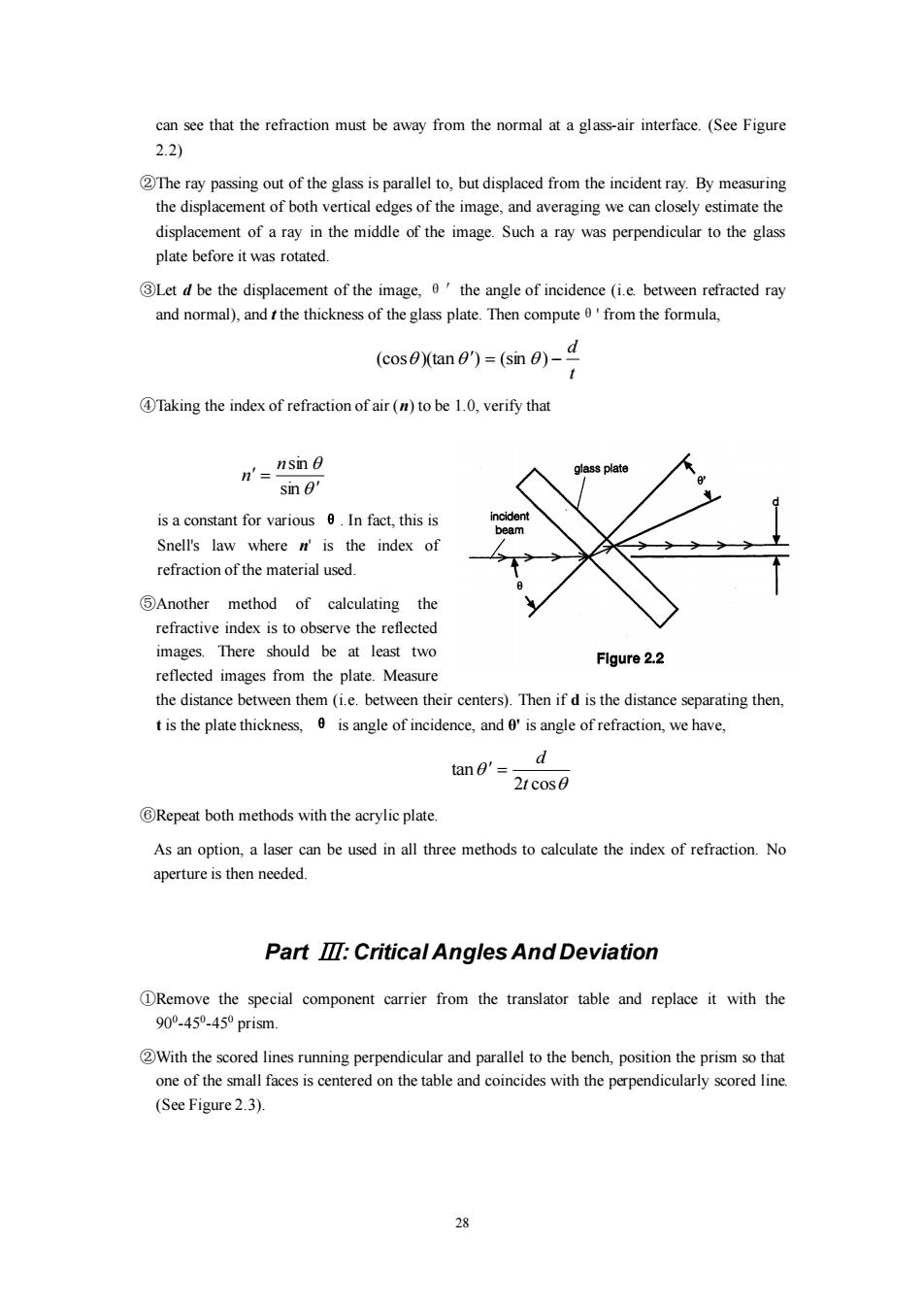正在加载图片...

can see that the refraction must be away from the normal at a glass-air interface.(See Figure 2.2) 2The ray passing out of the glass is parallel to,but displaced from the incident ray.By measuring the displacement of both vertical edges of the image,and averaging we can closely estimate the displacement of a ray in the middle of the image.Such a ray was perpendicular to the glass plate before it was rotated. 3Let d be the displacement of the image,0'the angle of incidence(i.e.between refracted ray and normal),and t the thickness of the glass plate.Then compute 0'from the formula, d (cos)(tan ')=(sin 0)- 4Taking the index of refraction of air(n)to be 1.0,verify that n'=nsin glass plate sin' is a constant for various e.In fact,this is incident Snell's law where n'is the index of refraction of the material used. 5Another method of calculating the refractive index is to observe the reflected images.There should be at least two Flgure 2.2 reflected images from the plate.Measure the distance between them(i.e.between their centers).Then if d is the distance separating then, t is the plate thickness,0 is angle of incidence,and 0'is angle of refraction,we have, tan0'= 2tcos0 Repeat both methods with the acrylic plate. As an option,a laser can be used in all three methods to calculate the index of refraction.No aperture is then needed. PartⅢ:Critical Angles And Deviation DRemove the special component carrier from the translator table and replace it with the 90°.450.450 prism. 2With the scored lines running perpendicular and parallel to the bench,position the prism so that one of the small faces is centered on the table and coincides with the perpendicularly scored line. (See Figure 2.3). 2828 can see that the refraction must be away from the normal at a glass-air interface. (See Figure 2.2) ②The ray passing out of the glass is parallel to, but displaced from the incident ray. By measuring the displacement of both vertical edges of the image, and averaging we can closely estimate the displacement of a ray in the middle of the image. Such a ray was perpendicular to the glass plate before it was rotated. ③Let d be the displacement of the image, θ′the angle of incidence (i.e. between refracted ray and normal), and t the thickness of the glass plate. Then computeθ' from the formula, t d (cos )(tan ) = (sin ) − ④Taking the index of refraction of air (n) to be 1.0, verify that = sin nsin n is a constant for various θ. In fact, this is Snell's law where n' is the index of refraction of the material used. ⑤Another method of calculating the refractive index is to observe the reflected images. There should be at least two reflected images from the plate. Measure the distance between them (i.e. between their centers). Then if d is the distance separating then, t is the plate thickness, θ is angle of incidence, and θ' is angle of refraction, we have, 2 cos tan t d = ⑥Repeat both methods with the acrylic plate. As an option, a laser can be used in all three methods to calculate the index of refraction. No aperture is then needed. Part Ⅲ: Critical Angles And Deviation ①Remove the special component carrier from the translator table and replace it with the 900 -450 -450 prism. ②With the scored lines running perpendicular and parallel to the bench, position the prism so that one of the small faces is centered on the table and coincides with the perpendicularly scored line. (See Figure 2.3)